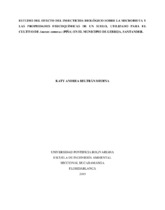| dc.contributor.advisor | Kopytko, María Irena | |
| dc.contributor.author | Beltrán Medina, Katy Andrea | |
| dc.coverage.temporal | 2019 | |
| dc.date.accessioned | 2020-11-13T16:52:16Z | |
| dc.date.available | 2020-11-13T16:52:16Z | |
| dc.date.issued | 2019-05 | |
| dc.identifier.uri | http://hdl.handle.net/20.500.11912/6392 | |
| dc.description | 117 páginas | spa |
| dc.description.abstract | En el presente proyecto se realizó un estudio del efecto de insecticida biológico sobre la microbiota y las propiedades fisicoquímicas de un suelo, cultivado con Ananas comosus (piña) en el municipio de Lebrija, Santander. Para este efecto se tuvo en cuenta las áreas denominada: Blanco (B), sin cultivo y sin fumigación, control (C), sembrado con piña, pero sin fumigación y el FB, con siembra y fumigación. Para los análisis fisicoquímicos se aplicaron métodos estándar y para el estudio microbiológico utilizó la técnica de metagenómica. Los tres suelos presentaron al inicio igual textura franco arcilloso — arenoso, siendo el C, con mayor porcentaje de limo, mayor porosidad (25,6%), mayor pérdida de humedad, alta acidez, relacionada con el bajo pH y la disponibilidad de aluminio intercambiable, cual puede ejercer efecto tóxico en estas condiciones. Las tres áreas experimentales presentaron al inicio bajo porcentaje de materia orgánica (1,7-2,5%) al igual que carbono orgánico (0.61-0,96%) y una baja capacidad de intercambio catiónico (7,7-12,4 meq /100g). Se demostró que, a lo largo del tiempo de experimentación, las propiedades fisicoquímicas no se alteraron de manera significante al aplicar el producto natural para la eliminación simultanea de hormigas y Dysmicocus brevipes que atacan el cultivo. Los análisis microbiológicos reportan en el suelo FB un mayor porcentaje del género Bacillus del 2,13% a 15,16%, contrastado con Proteobacterias que solo se identificó en el suelo B (5,14%) en la muestra inicial y en el suelo C en todas las muestras con un aumento progresivo hasta el 6,43% final. El insecticida biológico no afecta la microbiota del suelo, por lo cual la población microbiana es constante durante el tiempo de experimentación, pero es poco diversa para un sistema biogeoquímico tan amplio como el suelo. Sin embargo, el aumento de la población de Bacillus en el suelo FB podría relacionarse con la adición del bioinsecticida. | spa |
| dc.description.abstract | In this Project, it was made a study about the effect of the biological insecticide over the microbiota chemical physical properties of a soil, cultivated with Ananas comosus(pineapple) in the municipality of Lebrija, Santander. For this effect, it was taken into account the areas named: target (B) without crops either fumigation, control (C) cultivated with pineapple, but without fumigation, and the FB, with crops and fumigation. Chemical physical analysis applied standard methods and the microbiological study used the technic Metagenomics. At the beginning, the three soils showed the same texture with an aspect clay loam-gritty, being the C with a bigger percentage of limo, more porosity (25,6%), a bigger moisture loss, high acidity related to the pH and the interchangeable availability of aluminum, that can cause a toxic effect under these conditions. The three experimental areas, at first, presented a low percentage of organic material (1,7-2,5%), the same as organic carbon (0.61-0,96%), and a low capability of cationic exchange(7,7-12,4meq/100g). It was demonstrated that along the experimental time, the chemical physical properties remained without any meaningful alteration when applying the natural product, for the simultaneous elimination of ants and Dysmicocus brevipes that attack the crop. The microbiological analysis report on the ground a larger percentage of the Bacillus gender between the 2,13% to 15,16%, in contrast to Proteobacterias that was only identified in the soil B (5,14%) in the initial sample and in the soil C in all the samples with a progressive increase until the 6.4% final. The biological insecticide doesn't affect the microbiota of the soil, whereby the microbial population is constant during the experimental time but is a little diverse for a biogeochemical as large as the soil. Nevertheless, the increase of the Bacillus population in the soil FB could be related to the addition of the bioinsecticide. | eng |
| dc.format.mimetype | application/pdf | |
| dc.language.iso | spa | |
| dc.publisher | Universidad Pontificia Bolivariana | spa |
| dc.rights | Attribution-NonCommercial-NoDerivatives 4.0 International | * |
| dc.rights.uri | http://creativecommons.org/licenses/by-nc-nd/4.0/ | * |
| dc.subject | Lebrija (Santander, Colombia) | spa |
| dc.subject | Insecticidas | spa |
| dc.subject | Microbiota | spa |
| dc.subject | Cultivo de piña | spa |
| dc.subject | Piña | spa |
| dc.subject | Fisicoquímica | spa |
| dc.title | Estudio del efecto del insecticida biológico sobre la microbiota y las propiedades fisicoquímicas de un suelo, utilizado para el cultivo de ananas comosus (piña) en el municipio de Lebrija, Santander | spa |
| dc.type | Trabajo de grado | spa |
| dc.publisher.department | Escuela de Ingenierías | spa |
| dc.publisher.program | Ingeniería Ambiental | spa |
| dc.type.hasVersion | publishedVersion | spa |
| dc.description.sectional | Bucaramanga | spa |
| dc.description.degreename | Ingeniero Ambiental | spa |


